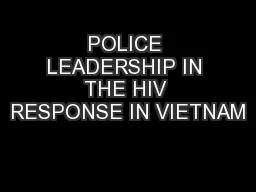

CLEPHIDLO Satellite Session Law Enforcement and HIV Network ICAAP 11 2013 Bangkok Thailand LAM TIEN DUNG Peoples Police Academy VIETNAM 2013 Current national HIV prevalence is 243 per 100000 ID: 627366
Download Presentation The PPT/PDF document "POLICE LEADERSHIP IN THE HIV RESPONSE IN..." is the property of its rightful owner. Permission is granted to download and print the materials on this web site for personal, non-commercial use only, and to display it on your personal computer provided you do not modify the materials and that you retain all copyright notices contained in the materials. By downloading content from our website, you accept the terms of this agreement.
Slide1
POLICE LEADERSHIPIN THE HIV RESPONSE IN VIETNAM
CLEPH-IDLO Satellite Session Law Enforcement and HIV NetworkICAAP 11, 2013, Bangkok, ThailandLAM TIEN DUNGPeople’s Police AcademyVIETNAMSlide2
2013
- Current national HIV prevalence is 243 per 100,000
+ Among male 66.3%
+ Among female 33.7%
+ Among drug user 39.8%
+ Among sex worker 20%
+ Among MSM 2.3%
*Figures: Ministry of Health (first 6 months report of 2013)
HIV in Vietnam
1990
First case identifiedSlide3
Sex work
MSM
Sex work is an administrative offence but in 2012 the National Assembly revised the law to end compulsory detention for sex workers. Monetary fines still exist.
Homosexuality is not illegal but highly stigmatised
Legal situation regarding most-at-risk
populations (MARPs) in Viet Nam
Drug use
Drug use was decriminalised in 2009 through its removal from the Penal Code. Remains an administrative offence punishable by up to 2 years in compulsory detention.Slide4
People’s Police Academy (PPA) activities relating to MARPs
Before 2012, PPA did not have any engagement with harm reduction programs for MARPs2012 – PPA was represented at 2 day regional seminar on ‘Law Enforcement and Harm Reduction’ in Bangkok2012 – PPA representative participated in workshop on ‘Policing Diverse Communities in Southeast Asia’ in Melbourne
2013 – 6 PPA staff undertook 3 week training in ‘Police as Collaborative Leaders in the HIV response’ in Sydney and MelbourneSlide5
Initiatives for police engagement
in harm reduction- Training for recruits at PPA regarding working with MARPs and HIV:+ Established working group for delivering training at the People’s Police Academy+ Revise UNODC documents of Training on HIV for Police Services
+ Discuss to incorporate knowledge of HIV for police in lectures of students in PPASlide6Slide7
Initiatives for police engagement
in harm reduction- Partnership programs with HIV projects+ Collaboration with SCDI+ Workshop: Enhancing partnerships between LEAs and CSOs in the context of drug use and HIV
+ Chance of collaboration with VNMSM, PLHIV, USAID pathways, FHI, BABSEASlide8
Challenges to increasing police support for harm reduction
Perception that HIV prevention is not the role of the policeNegative police attitudes towards MARPs
Poor history of multi-sectoral collaboration
The use of quotas as measures of police performanceSlide9
What leadership role does the PPA have in HIV prevention among MARPs?
As an educational institution, the role of the PPA is to provide excellent quality, evidence-based education to police - in both recruit and in-service training phases – in collaboration with key stakeholders, to improve the police role in the HIV responseSlide10
Thank you: Questions?
Follow LEAHN online! www.leahn.org @LEAHNetwork LEAHN